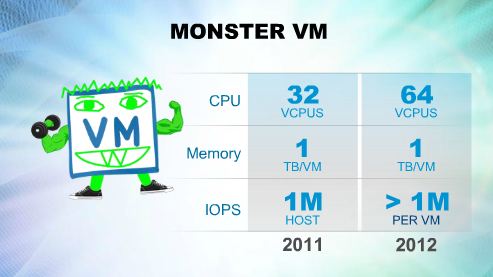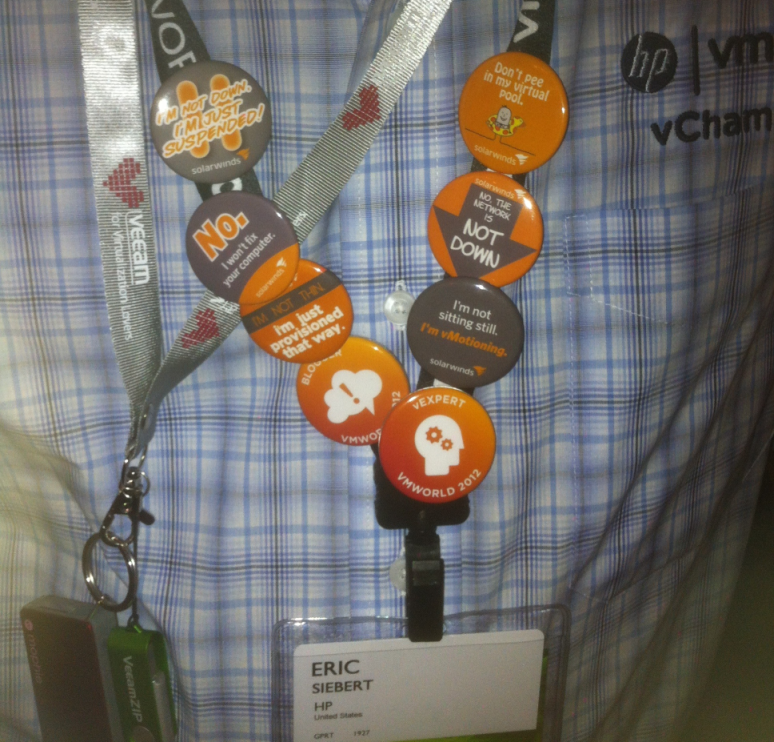Well, technically this is day 2 at the Welcome Reception opened on Sunday evening this year. At the opening keynote in the morning Paul Maritz presented before passing off to his replacement from EMC, Pat Gelsinger. VMware showed off to their vision for the future and laid the groundwork for the other announcements that they had. Perhaps the biggest announcement centered around their vRAM licensing model which has been not received well by their customers. Last year when they launched vSphere 5 they also first announced the new licensing model based on vRAM usage. As expected there was a huge customer outcry as licensing costs for many customers would be much higher with vSphere 5. VMware reacted to this by slightly changing the model to offer more vRAM entitlements per vSphere edition. This didn’t do much to relieve customer concerns with the licensing model but like it or not customers had to accept it.
So fast forward to this year, VMware simply said in the keynote that the vRAM licensing model is no more without much explanation on why they made the change. There were probably several reasons for this:
- Customers still did not like it and are more willing to like at alternative hypervisors.
- Increased competition from Microsoft, vSphere offered much more value and features compared to Hyper-V, and when you have a good product people are willing to pay for it because Hyper-V was very lacking. Now that Hyper-V is catching up even closer to vSphere with the upcoming Windows Server 2012 release it becomes more of a viable alternative for customers. So the cost vs. features argument is not going to be as effective anymore.
- More focus on cloud suites and management products. It used to be VMware’s main source of revenue was ESX/ESXi and vCenter Server licenses. Now they have a whole slew of other products they can make money on as well. With the core hypervisor becoming commoditized the focus is on all the other products that sit on top of it.
With yet another licensing change, despite being beneficial to customers, VMware has left a bad taste in the mouths of customers and memories linger. So this backpedaling may not be enough to stop customers from looking at alternatives to vSphere. You can read the new licensing details in this updated vSphere pricing and packaging document. VMware also announced new suites of vCloud products as they attempt to bundle products together. You can still by products a la carte but VMware is moving towards the suite model in the future. Isn’t VMware licensing fun, it’s just like a saying we have in Colorado, don’t like the weather, wait an hour and it will change. Just when you thought you understood VMware licensing it changes. You can read more on the vCloud Suites at this page and also on the product datasheet. There is a free upgrade path for customer with Enterprise Plus licenses and current SnS to the vCloud Standard Suite.

Other announcements centered around the new vSphere 5.1 release which was officially announced and Stephen Herrod covered, however it won’t be available until Sept. 11th. This a point release so there are not a huge number of big new features but it still has a lot of good stuff in it. You can read the general What’s New list here and there a bunch of new technical papers that cover it in detail. One of the big things is the updated Web UI client that provides the full functionality of the vSphere Client and also a unified interface across all the VMware products like vCloud Director. Yet better get used to because VMware intends to bury the vSphere Client in the next major release like they did with the ESX hypervisor. Other big features are the new ability to do a vMotion with shared storage, bigger VMs, no downtime VMware Tools upgrades (yes!), vSphere Data Protection (detailed post coming soon) and a new SE Sparse virtual disk type that you can’t use yet until the next version of View. They also previewed some of their big storage directions with Virtual Volumes (vVols), Virtual Flash Cache and their Virtual SAN (vSAN).

Here’s a slide from the VMware opening keynote that illustrates how much the Monster VM has been working out from vSphere 5.0 to vSphere 5.1, check out the big guns on that thing:

Later that evening I attended the SolarWinds vMixer party and met a lot of great people there including my old friend and a virtualization legend, Ken Cline. Also met some of the original Hyper9 guys like David Marshall and John Meadows who there in the early days before the SolarWinds acquisition. SolarWinds had some real cool geeked out buttons with lots of catchy and funny phrases on them which made a nice addition to my lanyard. Be sure and check out their great VMware management products which can add a lot of value to your VMware environment.

All in all a great day and look forward to what day 2 brings.



